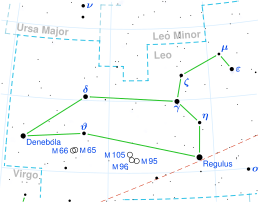astro.wikisort.org - Star
K2-18, also known as EPIC 201912552, is a red dwarf star located 124 light-years (38 pc)[4] from Earth, in the constellation of Leo.
 | |
| Observation data Epoch J2000.0 Equinox J2000.0 | |
|---|---|
| Constellation | Leo |
| Right ascension | 11h 30m 14.518s[1] |
| Declination | +07° 35′ 18.26″[1] |
| Apparent magnitude (V) | 13.50[2] |
| Characteristics | |
| Evolutionary stage | Red dwarf |
| Spectral type | M2.8[3] |
| Astrometry | |
| Proper motion (μ) | RA: −80.377[1] mas/yr Dec.: −133.142[1] mas/yr |
| Parallax (π) | 26.2686 ± 0.0546 mas[1] |
| Distance | 124.2 ± 0.3 ly (38.07 ± 0.08 pc) |
| Details | |
| Mass | 0.495[4] M☉ |
| Radius | 0.469[4] R☉ |
| Luminosity | 0.0234[5] L☉ |
| Temperature | 3,503[4] K |
| Metallicity [Fe/H] | 0.123±0.157[6] dex |
| Other designations | |
| Database references | |
| SIMBAD | data |
Planetary system
The star has an exoplanet, called K2-18b, a super-Earth located within the habitable zone of K2-18.[7][8] It is the first exoplanet in the habitable zone, albeit a hydrogen-rich sub-neptune,[9] to have water discovered in its atmosphere. The star also has a second planet K2-18c,[10] which is proven by system tidal simulation to be a small gas giant.[11]
| Companion (in order from star) |
Mass | Semimajor axis (AU) |
Orbital period (days) |
Eccentricity | Inclination | Radius |
|---|---|---|---|---|---|---|
| c | 5.62±0.84 M🜨 | 0.0670 ± 0.0002 | 8.962±0.008 | <0.2 | — | — |
| b | 8.63±1.35 M🜨 | 0.1591±0.0004 | 32.94488±0.00281 | — | — | 2.711±0.065 R🜨 |
References
- Brown, A. G. A.; et al. (Gaia collaboration) (August 2018). "Gaia Data Release 2: Summary of the contents and survey properties". Astronomy & Astrophysics. 616. A1. arXiv:1804.09365. Bibcode:2018A&A...616A...1G. doi:10.1051/0004-6361/201833051. Gaia DR2 record for this source at VizieR.
- Zacharias, N.; Finch, C. T.; Girard, T. M.; Henden, A.; Bartlett, J. L.; Monet, D. G.; Zacharias, M. I. (2012). "VizieR Online Data Catalog: UCAC4 Catalogue (Zacharias+, 2012)". VizieR On-line Data Catalog. Bibcode:2012yCat.1322....0Z.
- Montet, Benjamin T.; et al. (5 August 2015). "Stellar and Planetary Properties of K2 Campaign 1 Candidates and Validation of 17 Planets, Including a Planet Receiving Earth-like Insolation". The Astrophysical Journal. 809 (1): 25. arXiv:1503.07866. Bibcode:2015ApJ...809...25M. doi:10.1088/0004-637X/809/1/25. S2CID 33348734.
- Cloutier, Ryan; et al. (7 January 2019). "Confirmation of the radial velocity super-Earth K2-18c with HARPS and CARMENES". Astronomy & Astrophysics. 621. A49. arXiv:1810.04731. Bibcode:2019A&A...621A..49C. doi:10.1051/0004-6361/201833995. S2CID 118828975.
- Martinez, Arturo O.; Crossfield, Ian J. M.; Schlieder, Joshua E.; Dressing, Courtney D.; Obermeier, Christian; Livingston, John; Ciceri, Simona; Peacock, Sarah; Beichman, Charles A.; Lépine, Sébastien; Aller, Kimberly M.; Chance, Quadry A.; Petigura, Erik A.; Howard, Andrew W.; Werner, Michael W. (2017). "Stellar and Planetary Parameters for K2's Late-type Dwarf Systems from C1 to C5". The Astrophysical Journal. 837 (1): 72. arXiv:1701.00588. Bibcode:2017ApJ...837...72M. doi:10.3847/1538-4357/aa56c7. S2CID 25502982.
- Benneke, Björn; Werner, Michael; Petigura, Erik; Knutson, Heather; Dressing, Courtney; Crossfield, Ian J. M.; Schlieder, Joshua E.; Livingston, John; Beichman, Charles; Christiansen, Jessie; Krick, Jessica; Gorjian, Varoujan; Howard, Andrew W.; Sinukoff, Evan; Ciardi, David R.; Akeson, Rachel L. (2017). "Spitzer Observations Confirm and Rescue the Habitable-zone Super-Earth K2-18b for Future Characterization". The Astrophysical Journal. 834 (2): 187. arXiv:1610.07249. Bibcode:2017ApJ...834..187B. doi:10.3847/1538-4357/834/2/187. S2CID 12988198.
- "HABITABLE EXOPLANETS CATALOG". UPR. 7 March 2016. Retrieved 12 September 2019.
- "EPIC 201912552 b reality check drewexmachina 11-22-2015". Drew ExMachina. 7 March 2016. Retrieved 12 September 2019.
- No, the Exoplanet K2-18b Is Not Habitable
- "EPIC 201912552". Open Exoplanet Catalogue. 7 March 2016. Retrieved 12 September 2019.
- Ferraz-Mello, S.; Gomes, G. O. (2020). "Tidal evolution of exoplanetary systems hosting potentially habitable exoplanets. The cases of LHS-1140 b-c and K2-18 b-c". Monthly Notices of the Royal Astronomical Society. 494 (4): 5082–5090. arXiv:2005.10318. Bibcode:2020MNRAS.494.5082G. doi:10.1093/mnras/staa1110. S2CID 218763252.
На других языках
[de] K2-18
K2-18 ist ein Roter Zwerg in einer Entfernung von etwa 124 Lichtjahren von der Erde.- [en] K2-18
[ru] K2-18
K2-18 (EPIC 201912552) — звезда в созвездии Льва. Находится на расстоянии около 110 световых лет от Солнца. Вокруг звезды обращаются, как минимум, две планеты.Текст в блоке "Читать" взят с сайта "Википедия" и доступен по лицензии Creative Commons Attribution-ShareAlike; в отдельных случаях могут действовать дополнительные условия.
Другой контент может иметь иную лицензию. Перед использованием материалов сайта WikiSort.org внимательно изучите правила лицензирования конкретных элементов наполнения сайта.
Другой контент может иметь иную лицензию. Перед использованием материалов сайта WikiSort.org внимательно изучите правила лицензирования конкретных элементов наполнения сайта.
2019-2025
WikiSort.org - проект по пересортировке и дополнению контента Википедии
WikiSort.org - проект по пересортировке и дополнению контента Википедии
